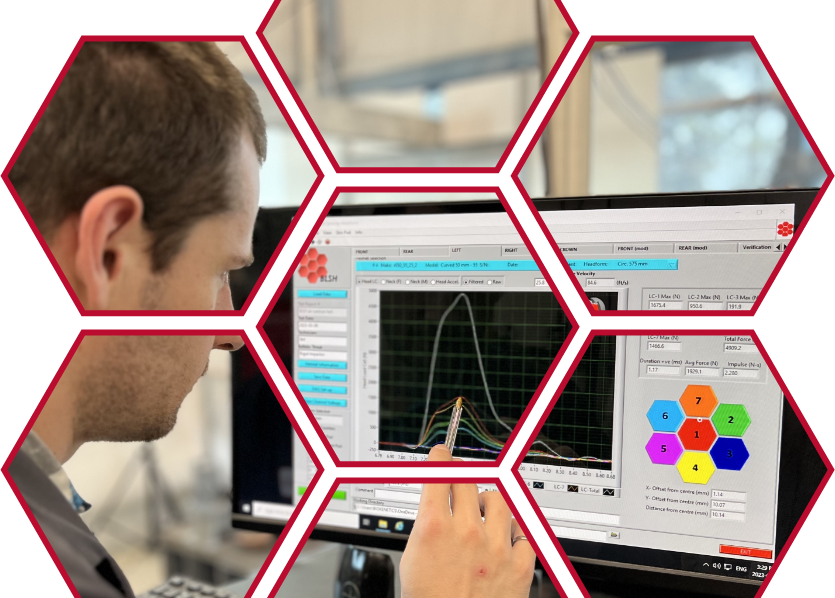Do you know what it takes to keep players safe on the field? Recent sports-related incidents like the commotio cordis suffered by safety Damar Hamlin and more historic events like the career-ending concussions of quarterback Steve Young remind us that the world of professional sports is far from risk-free. No matter how exceptional a player’s ability may be, there are countless variables that can contribute to the risk of serious injuries. Protective equipment cannot eliminate that risk but it can go a long way towards minimizing it.
At Biokinetics, we know that the key to mitigating risk on the field, as well as in other high-risk environments, is to utilize trustworthy data that provides an accurate picture of the exact risks and subsequent protective measures available. Based in Ottawa, Ontario, we are proud to offer comprehensive sports research services designed to help you reduce the risk of head and bodily injuries, assess the protective effectiveness of energy absorbing padding, and conduct expert injury analysis, event reconstructions, and more.
Below, we’ll take a quick look at some of the common types of injuries that pose a risk to athletes, what kinds of questions to ask when procuring protective equipment, and how the biomechanical analysis of risk factors can help everyone stay safe. Read on to learn more!
Not Always a Level Playing Field
While technological advances in protective equipment have helped to lower the overall occurrence of sports-related injuries, as players get stronger and faster, and the energy of collision increases, so too must protective equipment keep pace. The head and neck are at the highest risk. Spinal cord injuries (SCIs) and traumatic brain injuries (TBIs) can have profound effects on the victim’s quality of life and ability to continue as a professional athlete. Outside of these specific, severe grade injuries, other types of bodily harm caused by athletic activity include:
-
- Sprains and torn ligaments
-
- Fractured bones
-
- Permanent nerve damage
-
- Internal organ damage
- Chronic pain, and more.
Preventing Sports Injuries
The biggest factor when it comes to preventing serious sports injuries is taking a proactive approach to prevention. Identifying and using appropriate gear which has been properly designed and laboratory tested is essential to avoiding significant bodily harm. Essential sports protective gear (variable by sport and application) include:
Helmets
Helmets offer vital protection on the field, with different models including different design features to best meet the needs of the specific sport. For example, football and ice hockey helmets protect the head by encasing deformable energy absorbing padding beneath a rigid outer shell. The shell spreads out the impact so that a larger area of padding participates in absorbing the energy. Facial protection is offered by steel wire masks or polycarbonate shields. Helmets are meticulously tested to ensure they meet the unique standards for each sport and should be maintained and inspected regularly. Helmets are intended to prevent catastrophic injuries such as TBI and skull fracture, and they certainly factor into preventing minor abraisions and bruises. And while helmets can help reduce the risk of concussion, no helmet can prevent all concussions.
Mouth Guards/Eyewear
Taking a hockey puck, football, or even full body impact that leads to the face can cause significant harm without protective measures in place. Mouth guards help to protect your teeth, tongue gums and other soft tissues inside the mouth, and may even lessen the impact on your jaw and jaw joint. And while standards exist for the materials and care of mouth guards, there are no impact performance test standards for mouth guards. It is important to have good fit and retention of the mouth guard, because it needs to stay in place during an impact.
Similarly, visors and protective eyewear can be a significant form of protection against sports-related projectiles and serve as a barrier against impact and debris that can lead to ocular damage.
Padding
Alongside helmets, body padding can go a long way when it comes to lessening the severity of a serious impact on the field. Pads are designed to attenuate the kinetic energy and spread the impact force over a larger area in an effort to prevent soft tissue injuries, contusions and fractures. Furthermore, padding must not only provide adequate impact absorption, but it also needs to be lightweight and avoid inhibiting a player’s range of motion or speed. Extensive sports testing continues to be done on new and evolving forms of lightweight body padding for sports purposes. As new energy absorbing materials emerge and rapid manufacturing methods become available, new padding designs are quickly evolving.
Sports Research and Impact Injury Analysis with Biokinetics
Founded in 1975, Biokinetics is proud to have created a foundation of safety and knowledge under every research initiative we undertake. Mitigating the risk of bodily harm during sporting activity remains a dedicated area of expertise for our team, with dedicated biomechanical engineers and research professionals conducting extensive analysis in our laboratory in Ottawa, Ontario. We are proud to conduct thorough risk and performance analyses on helmets, padding, mouth guards, and other protective equipment and to offer dedicated injury reconstruction and consulting services.
Learn more about our sports research services by contacting our team directly today!

